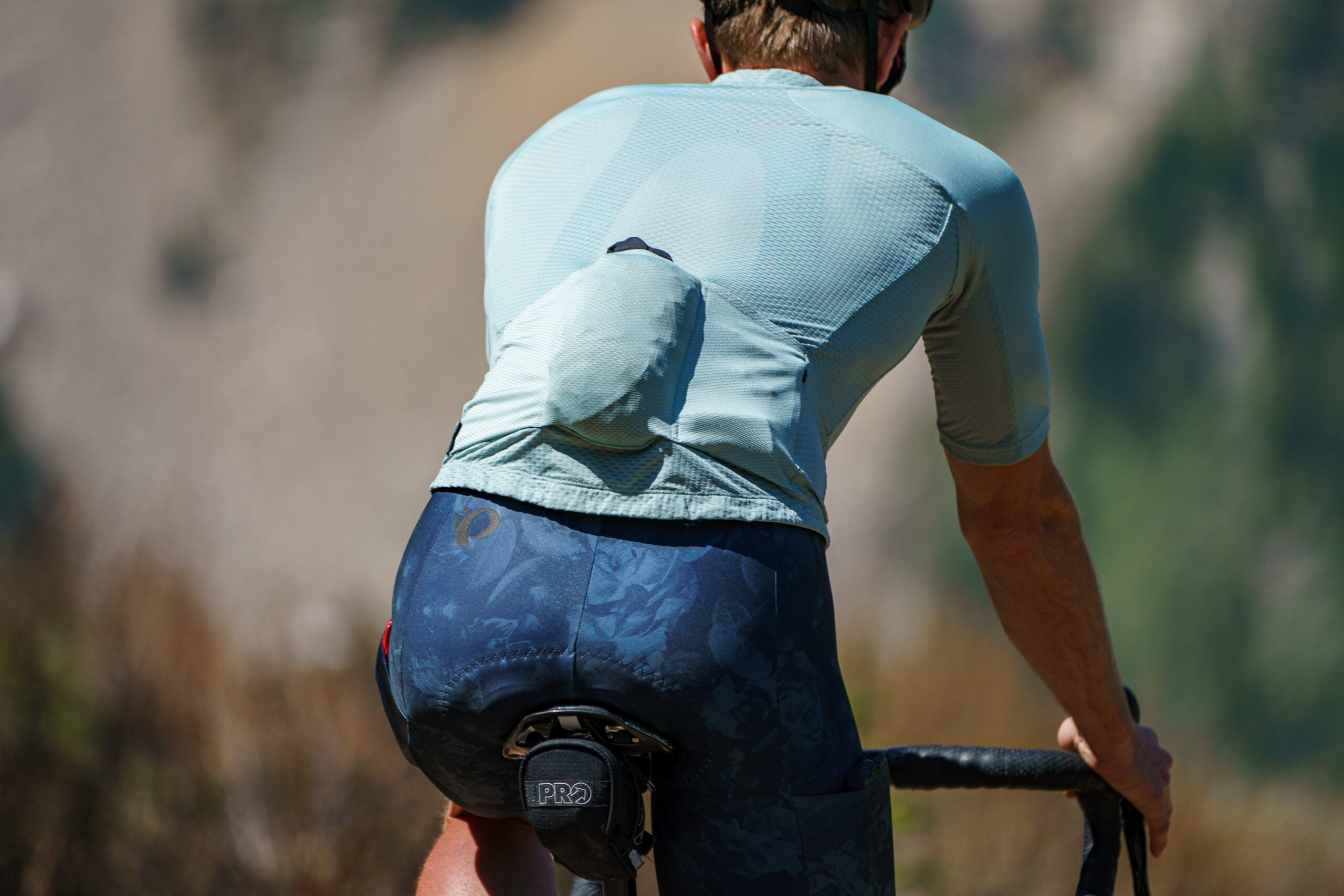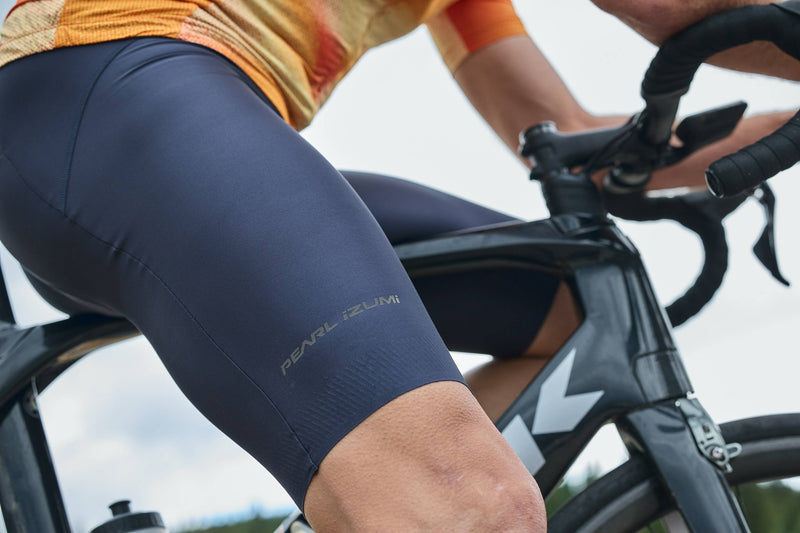We crafted our first synthetic chamois (“shammy”) in 1983. Leading up to this technological milestone, leather chamois had been the norm, requiring time-intensive maintenance and care, without the suspension or moisture-wicking properties we enjoy today. Since that pivotal breakthrough, we’ve continued to test, refine, and innovate our chamois designs. Read on for an overview of our current levels of support and tips on how to pick a chamois for your ride.

Why Ride With a Chamois?
Our most important contact point with the bike is at the saddle, and most of our pressure on the seat is concentrated at two, roughly quarter-sized spots: the sit bones. What you wear while riding can greatly impact this body-bike intersection. And because cycling involves the repetitive motion of pumping one’s legs to turn the pedals, you may experience significant discomfort if what you’re wearing doesn’t solve the challenges posed by riding—friction and moisture. Wearing shorts or bibs lined with a chamois pad greatly reduces the potential for saddle-related ailments by helping to distribute pressure more evenly across a wider platform. But not all chamois are created equal.
The chamois serves three purposes:
RIDER SUPPORT – Padded shorts or bibs provide skeletal support and suspension by creating space between rider and saddle and distributing pressure. Having a foundation of support beneath key contact points improves long ride comfort while also maintaining better circulation.
KEEPS SKIN DRY – Chamois are constructed from breathable, wicking materials to help keep skin dry in this sensitive area of the body by actively drawing moisture away, facilitating evaporation.
REDUCES FRICTION – Wearing shorts constructed from compressive materials and having a chamois designed to move with you minimizes friction from the repetitive motion of riding, thereby reducing the chance for hot spots and skin irritation to occur.
Our Process
For nearly 30 years we’ve worked with our Italian manufacturing partner to create unique, proprietary chamois designs that elegantly execute these three goals, rather than selecting a pre-engineered chamois from a third party provider.
R&D
Using super thin pressure sensors mounted on an assortment of popular bike saddles, our product engineers are able to observe where riders feel the most pressure, and importantly, where they don’t. We translate this pressure-mapping research to our chamois design by utilizing high density materials in high pressure zones, while carving out unneeded material from lower pressure areas to deliver a chamois that’s supportive but not overbuilt and bulky.
The next step is dialing in the perfect combination of material densities. A thicker chamois does not necessarily mean a more comfortable ride. It’s about having a material, or combination of, that creates a resilient base that doesn’t become packed out beneath the weight of the rider. More premium chamois offerings deliver better ride comfort through higher performance materials and complex designs that allow perfectly targeted support.

The last step in the process is ensuring the interface between the chamois and rider is super smooth, highly breathable and ultra-wicking. Our unique Boundary Layer top-sheet creates a “floating” surface that helps the chamois find a natural position against the body, making it less prone to bunching and wrinkling. The Boundary Layer is so effective at preventing chafing that it eliminates the need for chamois creams for most people, which can actually clog the pores in breathable materials, making them less able to move moisture away from skin and actually increasing friction.
Once the design is dialed, our network of nearly 500 wear test riders across the globe put prototypes through hundreds of hours of riding to provide unbiased feedback to the product development team. The input we get from these riders directly guides how we improve and refine our products so that when they get to you, all you have to do is focus on the ride.

For Women
Our men’s and women’s-specific chamois are developed in parallel but involve two distinct engineering processes. We don’t just change the shape of an existing chamois to make it a “women’s specific” version. Depending on the feedback from our wear test team, our women’s-specific chamois could have an entirely different material package than the men’s version.
In the process of developing the Women’s Levitate PRO Chamois, female testers asked to update the women’s specific shape to reduce friction on the sides of the chamois.This process of design, testing, listening, and refining typically takes a couple years to complete.
We hesitate to use the word “perfect” but we’ve come a long way over the years and believe that our chamois are pretty darn good. Today, we offer multiple levels of chamois so that every rider can benefit from our in-house innovation process.
Levitate™ Series
The Levitate™ family represents our latest innovation in chamois technology. By combining a multi-density Suspension Core™, super-soft 1:1® Boundary Layer top sheet, and seamless Infinite Edge™ transitions, the Levitate lets you float through road and trail chatter like never before.
Levitate™ PRO
The pinnacle of comfort and performance, this chamois pad offers more support with better stretch and breathability than any on the market. The PRO Next-Gen Suspension Core™ uses ultra-high-density layers to distribute your body weight over a larger area for more comfort, even deep into a ride when most chamois are packed out. It features our softest, highest stretch 1:1 Boundary Layer™ that moves with you in and out of the saddle to minimize friction. Whether you’re riding for one hour or twelve, nothing rides better.

Levitate™ PLUS
With a ride quality similar to the PRO, this chamois pad delivers comfort and performance that’s on par or better than most other high-end offerings. The PLUS Next-Gen Suspension Core™ uses high-density layers to distribute your body weight over a larger area for more comfort, even deep into a ride when most chamois are packed out. It features a moisture-wicking 1:1 Boundary Layer™ that moves with you in and out of the saddle to minimize friction. This is a daily driver chamois that is ready to go the distance.

Levitate™
Based on the same design philosophy as the more premium PRO and PLUS, this chamois pad delivers incredible performance at a more accessible price point. The key difference is that it’s cut from a single layer of medium-density material, with a thicker cross-section providing comfortable support to the most high-pressure areas. An integrated boundary layer keeps soft, fast-drying fabric next to the skin to minimize friction. This chamois punches above its weight, delivering a ride on par with most mid-range offerings.
Escape 1:1® Collection
Released in 2016, the Escape 1:1® chamois platform introduced two-piece construction, with a Suspension Core™ providing cushioning support and a floating top sheet to reduce friction. It redefined next-to-skin comfort and all-day support without feeling bulky.



PRO Escape 1:1 ® Chamois
This premium chamois features a high-density, three-layer Suspension Core, and an independent, ultra-soft top sheet. The PRO chamois promises plush support even on the longest rides.
Elite Escape 1:1® Chamois
A high-density, two-layer Suspension Core and independent, next-to-skin top sheet layer work together to deliver reliable, long-ride supportive comfort.
Select Escape 1:1® Chamois
A single-layer chamois featuring mid-level support, designed with an emphasis on next-to-skin comfort and breathability.

Wear & Care
Cycling bibs and shorts with an integrated chamois are designed to be worn over bare skin as extra undergarments increase the risk of bunching, wrinkles, and ultimately chafing. Additionally, unnecessary layers of fabric between you and the chamois reduces its ability to efficiently wick sweat away from your body.
The earliest chamois were made out of leather, or animal pelts, and required the application of creams or oils to ensure they stayed pliable. The advent of the synthetic chamois eliminated the need for such lubricants. Still, many cyclists maintain that applying a chamois cream will reduce chafing and improve ride comfort. It’s not quite that simple: oils can block the moisture-wicking pores in the chamois and hinder the material’s breathability and ability to facilitate evaporation. Should you need a little extra relief, our advice is to apply chamois cream directly to your body and only in the creases, not slathered on the surface of the pad.
Chamois Care
Bibs and cycling shorts are an investment and our products are designed to see you through years of riding. Follow these steps to maximize the lifespan of your favorite shorts or bibs.
Cold rinse, with fragrance-free detergent.
Before you even throw your shorts in the hamper, turn them inside out to air dry after a ride. This allows sweat and moisture to evaporate early, rather than linger and fester. When it is time to wash, leave them inside out and choose a fragrance-free detergent. Similar to “chamois creams,” fragrance compounds and oils found in many detergents and fabric softeners can actually bond to the chamois fabric, trapping bacteria. Mix soap with water in the machine rather than pouring directly on clothes. Always wash with cold water; this keeps colors bright and saves energy.
Air dry whenever possible.
Skipping the dryer reduces energy use and also extends the longevity of foams found in chamois, elastics, and bib/short silicone grippers, while reducing the risk of fabric pilling.
Remember to close zippers, bib clasps, and other fasteners
If you do dry your items, close all fasteners to reduce wear-and-tear and use the “gentle” cycle on Medium or Low heat.
Enjoy years of riding with your favorite gear!
Properly caring for your items not only means you get to ride in your favorite clothes for longer but also keeps them from becoming waste prematurely.





Comments